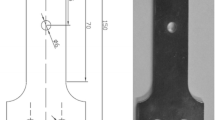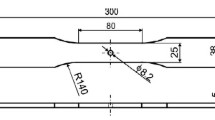Two main cracks appear on the upper end of the inner hole of a hammer anvil after 130 hours’ impact. The fracture morphology, microstructure, metallographic microscopy results and nonmetallic inclusions of the cracked anvil are analyzed. The chemical composition and mechanical properties of the anvil are examined. In its material, carbon content is shown to be higher than the highest limit of 40CrMnMo specifications, with multiple sulfide inclusions, which affects the comprehensive mechanical properties to some extent. The cracks originate from mechanical fatigue, propagating from the stress concentration point near the upper end of the inner hole. Low material toughness and high local working stresses are the main contributors of fatigue cracking. The lines of optimizing the operating conditions and improving the anvil structure and material are put forward.











Similar content being viewed by others
References
K. Wang, “Research and application of percussion rotary drilling technology in petroleum drilling,” Oil Drill. Prod. Technol., 21, No. 5, 5–9 (1999).
X. Zhu and W. Liu, “The rock breaking and ROP rising mechanism for single-tooth high-frequency torsional impact cutting,” Acta Petrolei Sinica, 38, No. 5, 578–586 (2017).
Y. Deng, “Feasibility study and exploration on the application of rotary drilling technology in oil drilling,” Chem. Enterprise Management, 6, 171 (2016).
G. Bi, G. Li, Z. Qu, et al., “Rock breaking efficiency of the self-propelled swirling jet bit,” Acta Petrolei Sinica, 37, No. 5, 680–687 (2016).
J. Chen and Y. Zhai, “Mechanical analysis on working process of syzj type of impulsive load generator,” J. China Univ. Petroleum, 25, No. 2, 9–14 (2001).
X. Dong, J. Xiong, G. Wang, et al., “Study on running characteristic of oscillation impacter for oil-drilling,” J. Mech. Eng., 50, No. 21, 197–205 (2014).
Y. Geng, D. Li, and Y. Fan, “Cause analysis and balling prevention of TorkBuster drilling tools,” J. Oil Gas Technol., 36, No. 8, 154–158 (2014).
X. Zhou, J. Zhang, and D. Zhang, “Experimental application of TorkBuster torsional impactor in Yuanba region,” Drill. Prod. Technol., 35, No. 2, 15–17 (2011).
K. Wang, Y. Zhai, and J. Cai, “Detecting system for hydraulic percusive device,” J. China Univ. Petroleum, 25, No. 2, 34–37 (1995).
H. Zhang, Z. Suo, H. Zhang, and X. Liu, “The design and experiment of the retaining and sealing mechanism for hydraulic jet hammer,” China Petrol. Machin., 39, No. 8, 4–6 (2011).
G. Ma, H. Zhang, and J. Wang, “Designed and testing of the positive displacement motor driven rotary percussion drilling device,” China Petrol. Machin., 44, No. 6, 24–27 (2016).
H. Zhang, X. Liu, J. Wang, and M. Sun, “Structural design and motion simulation research on a new type composite rotary percussion drilling tool,” J. Mech. Strength, 39, No. 2, 392–396 (2017).
H. Zhang, Z. Suo, and J. Wang, “Failure analysis on the rupture of a hammer anvil,” J. Mater. Sci. Eng., 31, No. 3, 468–472 (2013).
Y. Jia and X. Lian, “Analysis on failure of tungsten carboide anvil,” Phys. Examin. Test., 26, No. 2, 61–62 (2008).
X. Tao, “Present situation and development trend of percussive rotary drilling technology,” Drill. Prod. Technol., 19, No. 1, 10–12 (1996).
H. Zhang, Z. Suo, and X. Tao, “The structural design and experimental study of the jet-type hydro-hammer,” China Petrol. Machin., 39, No. 7, 1–3 (2011).
Z. Suo, H. Yin, H. Zhang, et al., “Application of rotary-percussion drilling technology in Yi1 well of Inner Mongolia,” Exploration Engineering (Drilling and Tunneling), 41, No. 3, 18, 20–24 (2014).
L. Cao, M. Lei, Y. Bao, and H. Guo, “Application of hydraulic impactor in oil well,” Oil Field Equip., 34, No. 4, 100–101 (2005).
GB/T 3077-1999. Alloy Structure Steel, China National Standards.
Z. Ni and S. Zhang, “Failure analysis of the shaft of motorcycle clutch,” J. Mater. Sci. Eng., 27, No. 1, 78–82 (2009).
GB/T 1172-1999. Conversion of Hardness and Strength for Ferrous Metals, China National Standards.
GB/T 229-2007. Metallic Materials – Charpy Pendulum Impact Test Method, China National Standards.
GB/T 10561-2005. Steel – Determination of Content of Nonmetallic Inclusions – Micrographic Method Using Standards Diagrams, China National Standards.
B. Yang and T. Huang, Material Casting and Forming Engineering (China Material Engineering), Vol. 18, Chemical Industry Press, Beijing (2006).
J. Yang, C. Ling, J. Tang, et al., “Effects of nonmetallic inclusions on tensile strength and fracture behavior of wire rod for steel cord,” Heat Treat. Met., 37, No. 2, 32–36 (2012).
X. Sun, J. Yao, and J. Li, “Fracture analysis of the eccentric pin on the inlet structure from a hydraulicgenerator,” J. Mater. Sci. Eng., 26, No. 4, 650–653 (2008).
Acknowledgments
This paper was financed by the Advanced Drilling Technology and Equipment Project of the National High Technology Research and Development Program No. 863 of the Ministry of Science and Technology of China (project No. 2006AA06A109).
Author information
Authors and Affiliations
Corresponding author
Rights and permissions
About this article
Cite this article
Zhang, H.P., Sun, M.G. & Suo, Z.W. Assessment of the Fatigue Cracking Impact and Optimization of Operating Conditions of a Hydraulic Hammer Anvil. Strength Mater 52, 110–117 (2020). https://doi.org/10.1007/s11223-020-00156-z
Received:
Published:
Issue Date:
DOI: https://doi.org/10.1007/s11223-020-00156-z




